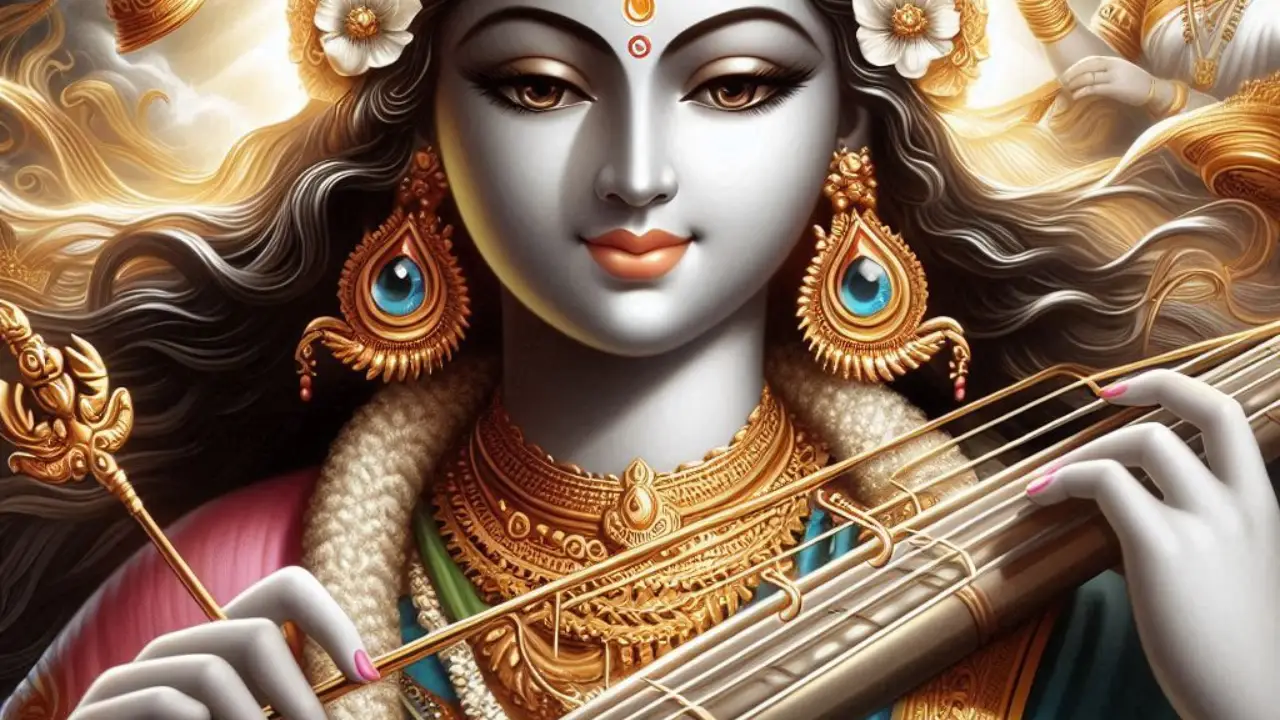Imagine a serene figure, draped in pure white, playing the veena with an ethereal grace that mesmerizes anyone who beholds her. This is Goddess Saraswati, the embodiment of wisdom, art, and music in Hinduism. Revered as the divine source of learning and creativity, she inspires countless artists, scholars, and musicians. Let’s delve into the enchanting influence of Saraswati on the arts and understand why she holds a special place in the hearts of her devotees.
The Divine Symbolism of Goddess Saraswati
Saraswati is often depicted with four hands, each holding a significant object: a veena, a book, a rosary, and a pot of water. Each element symbolizes a different aspect of life and learning. The veena represents the arts, music, and creative expression. The book signifies knowledge and wisdom, essential for intellectual growth. The rosary stands for spirituality and the inner journey of self-discovery. Lastly, the pot of water symbolizes purity and the power to sustain life. Together, these elements highlight the multifaceted nature of Saraswati’s blessings.
Saraswati’s Influence on Music
Music is considered a divine gift, and Saraswati is its celestial patron. The veena, an ancient string instrument, is her chosen medium to convey the sublime essence of music. Her association with this instrument underscores the belief that music is not just entertainment but a spiritual experience that elevates the soul.
Historical texts and scriptures often mention Saraswati’s role in guiding musicians and composers. For instance, the Vedas, the oldest sacred texts of Hinduism, are said to have been inspired by her. The Sama Veda, which is dedicated to music and chant, particularly emphasizes her influence. Many classical Indian musicians invoke Saraswati before performances, seeking her blessings for a flawless and inspired rendition.
The Role of Saraswati in Literature and Education
Goddess Saraswati is also revered as the goddess of learning and literature. Schools and educational institutions across India celebrate Saraswati Puja, seeking her blessings for academic excellence. This tradition underscores the belief that true knowledge transcends mere information; it is about understanding and wisdom.
A popular story from ancient scriptures narrates how the sage Vyasa composed the epic Mahabharata with Saraswati’s divine inspiration. Her influence ensured that the epic was not just a story but a repository of moral and ethical teachings, which continue to guide millions to this day.
Visual Arts and Goddess Saraswati
Saraswati’s influence extends beyond music and literature into the visual arts. Artists often depict her with a serene and composed demeanor, reflecting the inner calm and focus required for creative endeavors. Her association with the color white signifies purity, clarity, and the unblemished nature of true artistic inspiration.
Throughout history, Goddess Saraswati has been a muse for painters, sculptors, and dancers. Her imagery in temples and artworks often serves as a reminder of the divine inspiration behind all forms of creativity. In traditional Indian dance forms, performers invoke Saraswati to guide their expressions and movements, ensuring that their art remains a tribute to the divine.
Goddess Saraswati in Modern Times
In today’s world, where the pace of life is ever-increasing, Saraswati’s teachings hold even more relevance. The arts, often sidelined in the rush for material success, find renewed importance through her worship. Modern education systems increasingly recognize the value of integrating arts and creativity into their curricula, a practice that echoes the holistic approach of Saraswati’s teachings.
A contemporary example is the rise of interdisciplinary studies that combine arts with sciences, technology, engineering, and mathematics (STEAM). This approach nurtures creativity and innovation, reflecting Saraswati’s timeless wisdom that true learning encompasses both the intellect and the arts.
Personal Stories of Devotion
Many individuals have personal stories of how Saraswati’s blessings have guided their artistic and academic journeys. One such story is that of Ravi, a classical musician who struggled with stage fright. Before every performance, he would pray to Saraswati, seeking her blessings. Over time, he found that his anxiety diminished, and his performances became more soulful and confident. He attributes his transformation to the divine grace of Saraswati, which helped him connect with his inner muse.
Another inspiring story is that of Meera, a school teacher who faced challenges in making her students interested in learning. She started incorporating stories and creative activities into her lessons, drawing inspiration from Saraswati’s emphasis on holistic education. Her students not only excelled academically but also developed a love for learning, which Meera believes is the true blessing of Saraswati.
The Significance of Saraswati Puja
Saraswati Puja, celebrated during the festival of Vasant Panchami, is a special day dedicated to honoring the goddess. On this day, students place their books and musical instruments at her feet, seeking her blessings for wisdom and artistic skill. The rituals performed during Saraswati Puja emphasize the importance of starting any educational or artistic endeavor with a prayer to the goddess, acknowledging her role as the ultimate source of knowledge and creativity.
As we reflect on the profound impact of Goddess Saraswati on the arts and education, it becomes clear that her influence transcends time and culture. Whether you are a student, an artist, or someone seeking inspiration in life, invoking Saraswati can open the doors to new realms of creativity and wisdom.
Share your own experiences and stories of how Goddess Saraswati has inspired you in the comments below. Let’s celebrate the divine muse who continues to enrich our lives with her boundless grace.

